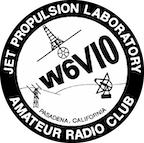By: Steve Townes, WB4ILW
I went up to the Mesa last Friday with Jonathan Cameron, KF6RTA, to evaluate the condition of the HF antennas. Here is a short update.
The Rohn HF tower with the 40 m and tri-band beams is definitely bent in the top segment. It looks like the combination of the weight of the two beams, the lever arm of the mounting pole and the wind put too much stress on the top-most supports. This also puts stress on the rotator and is likely why it quit working and was blowing fuses. It’s not clear what the ultimate solution is but we may need to replace the top section of the tower and rethink the antenna mounting. It may be OBE but a drone inspection of the tower for confirmation could be useful. If the top section is bent, that would probably mean taking it off and replacing. I’m not sure exactly which tower it is but if it is a Rohn 45G class tower, a replacement section is under $300 from HRO. Note that one can apparently contract directly with Rohn, or likely one of their contractors, for assembly http://www.rohnnet.com/tower-antenna-construction-services. I’m trying to find out if anyone knows the history of the tower. We’ll probably need to look more carefully at wind loading. (Consensus is building that it is a Rohn 45G but I’m trying to confirm)
We tried to crank down the tower section on the utility pole supporting the 160m inverted vee but it didn’t respond as we expected so we need to do a bit more thinking on that. We’ve requested Jan, WB6VRN, who has the most experience with this system, to give us some advice when he can. (Per Jan—and Walt, there may be a locking mechanism that will need some attention.) A drone inspection of the tower for confirmation could be useful. I’m not sure we could get a cherry picker in to this pole but we could get by with someone who can climb the standard wooden utility pole. If we can get this working, it does have potential for continued support of the 160m inverted vee (once the coax & connections are refurbished as needed) and maybe even a small HF beam with appropriate rotator.
The small tower down by the water tanks appears to be in good shape. We need to unravel the guy wires and crank it up to make sure. Once we do that, we should be able to put a rotator and beam on top. There will be lots of work to actually get to that point because we need to put in the junction box at the tanks, put connectors on the coax and control cables at both ends, refurbish/buy a rotor and beam, get a “cherry picker” to lift the beam and rotor to attach to the tower, attach the coax and control cables, crank it up and test it—doable but will take time and organization. The nice thing about this location is that it should be trivial to get a cherry picker in there to work on the antenna installation. I think Jonathan and I can handle getting the coaxes and cables fixed but we could probably use some help having a professional installation of the junction box (in the trailer, I think), grounding and cable supports like we have up by the big tower. Once we get that ship shape, I’m thinking of something like a Tennadyne T8 log periodic antenna that covers 13-30 MHz (good for MARS/CAPS coverage) and hopefully isn’t too big for the tower/rotator combination. The T8 runs about $900 and a rotator and control box should be less than $500. (Note that the new T8 that goes 10-30 MHz is about 3 times the price and really big so I’m not sure it would fit on the smaller tower in that location.
On another note, we’ve found that the R-7000 vertical on the Mesa has an SWR that is too high for the ALS-606 amp. This currently limits our ability to use it on the 14 MHz NASA frequency. We should have an antenna tuner and Chris and I have talked about the LDG AT-600ProII as a possibility. There are likely others. In the meantime, I’m attempting to refurbish an old manual MFJ tuner that we may be able to use until we can get an automatic one.
For operation in the 14-30 MHz band, a log-periodic antenna like the one above could ameliorate some of the requirement for an antenna tuner but it is a good idea in general to have an antenna tuner for non-ideal installations. We may also want to consider a wideband wire antenna(s) like the Tennadyne TD-SS120 or ones from B&W, etc., for operation between 1.8 MHz and 14 MHz.
